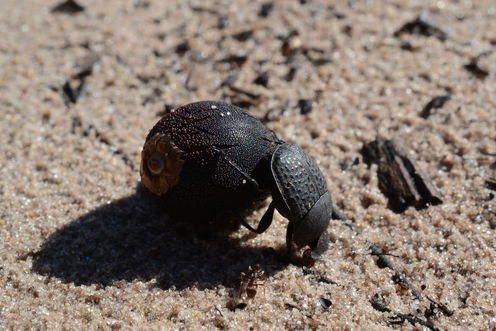Dung beetles find their food - which is dung - by its pungent smell. Once found, dung beetles then roll and bury dung balls or dung pellets to later eat or to lay eggs in. But in the De Hoop Nature Reserve of the southern Cape plants called Ceratocaryum argenteum have managed to dupe dung beetles into rolling and burying their seeds. These seeds look and smell like dung pellets, so this is a classic case of plants deceiving animals.
Ceratocaryum argenteum is a tall grass-like plant in the Restionaceae family and is a part of sand plain fynbos. Fynbos is the local name for Cape shrublands, a biome that regularly experiences natural fires. These seeds are the same rounded shape and brown colour as a dung pellet from local antelope like bontebok and eland. Fresh seeds are really stinky and the scent profile of the dung of these herbivores and that of the seeds is remarkably complex, yet similar.
Given the right weather conditions, such as after rain, within minutes of putting seeds out, dung beetles arrive and rapidly roll and bury the seeds. Dung beetles typically eat soft dung, mostly as developing larvae inside a dung ball but also, to a lesser degree, as adults. The hard seeds of Ceratocaryum argenteum are therefore inedible to dung beetles and thus there is no reward for the dung beetles that disperse these seeds.
Our research shows the deception is not that costly to the beetles as they do not lay eggs on the seeds. When they try to lay eggs in the hard seeds, they realise something is wrong and they leave.
Small mammals shy away
Originally, we thought that these large seeds would be dispersed and buried by small mammals in a process known as scatter-hoarding. Scatter-hoarders bury seeds and then later return to find their stash when they are hungry. Their memory is less than perfect and some buried seeds eventually escape seed predation, germinate and establish.
Two species of Cape small mammals are scatter-hoarders; the spiny mouse and the hairy footed-gerbil. But neither of these two species occurs in southern Cape sandy fynbos where Ceratocaryum argenteum grows.
Here the most common small mammal, the four-striped mouse, seems to be repelled by the seed coat. Interestingly, if the hard seed coats are cracked open, this rodent avidly consumes the inner nutritious part of the seed.
The benefit to the plant of being buried by dung beetles is very significant because large seeds do not easily get buried passively. Large seeds left on the soil surface would then be prone to incineration. This is through natural, mainly lightning-caused fires, that typically burn through fynbos about every 10 to 20 years. The seeds would also be prone to desiccation as they wait for post-fire conditions in which to germinate and establish. So burial is crucial.
Implications
This discovery has several implications. This is probably the best example globally of deception in plant seed dispersal. The only realistic previous example of deception of animal dispersers by plants, concerned red and black hard seeds, the so-called "lucky-beans". The idea was that these mimic red fleshy fruits and deceive birds into eating and dispersing them.
But often these seeds are poisonous and birds hardly ever take them. So, this is not deception but aposematism or warning colouration. Many animals use red and black colouration to warn predators that they are harmful.
The evolution of dung beetle deception in a fynbos plant implies the long term presence of dung and thus the presence of large herbivores. Fynbos is generally considered to be unpalatable and therefore that large herbivores would be absent.
In contrast, our results suggest the sustained presence of dung. It also raises the question of why dung beetle deception has not evolved in the herbivore rich savannas of Africa. I guess that this system works best in ecosystems where dung is in limited supply because the plant is so dependent on burial.
The final point regarding the significance of this work is that many novel natural history observations can still be made in the Western Cape and elsewhere. Although this is hardly big science emerging from big labs or big computers, I have been amazed at the enormous public and scientific interest this paper has had.
There certainly is large public interest in natural history and since the public often funds science, its great to have had public impact. I suspect that much of the public interest is because deception is the "dark" side of evolution, it is unexpected that plants can deceive animals. Also dung beetles are such interesting, hardworking and charismatic beasts; they attract public attention.
Jeremy Midgley, Professor at Department of Biological Sciences, University of Cape Town
This article was originally published on The Conversation. Read the original article.

